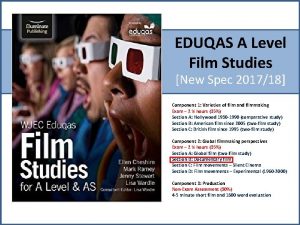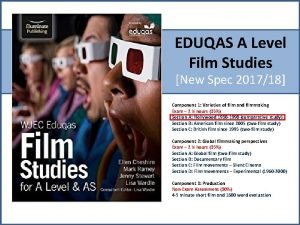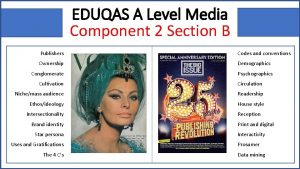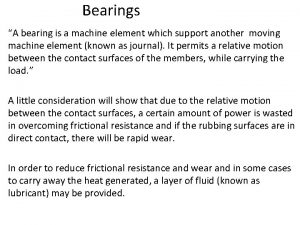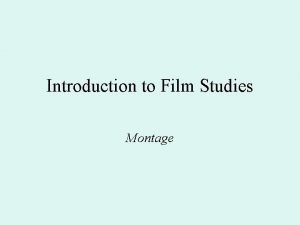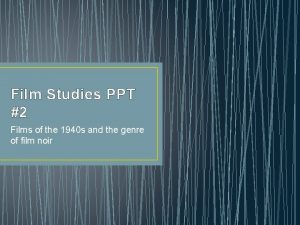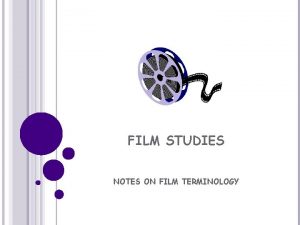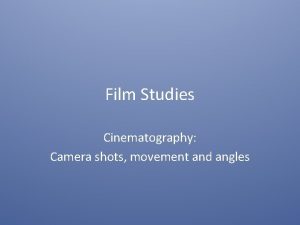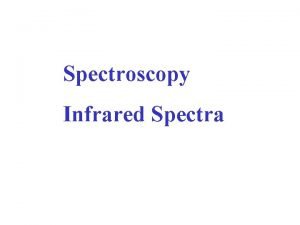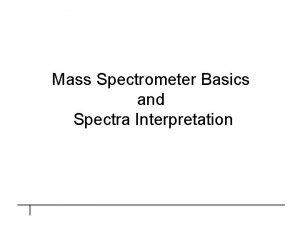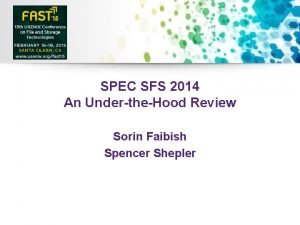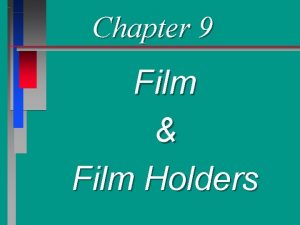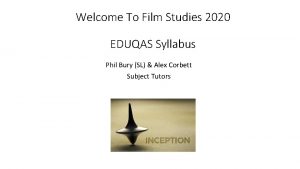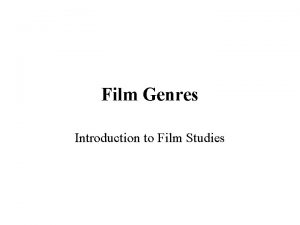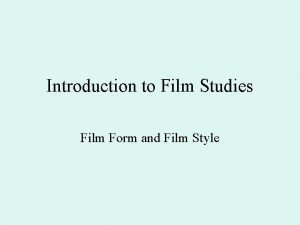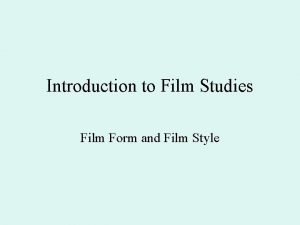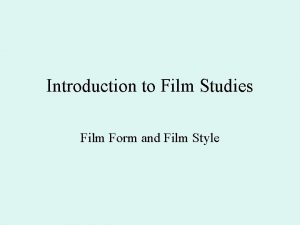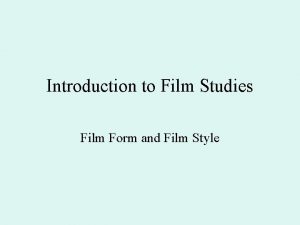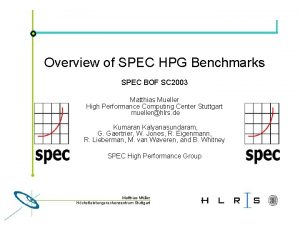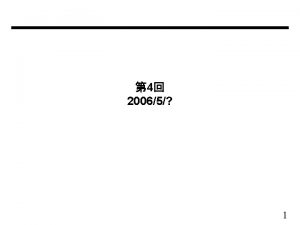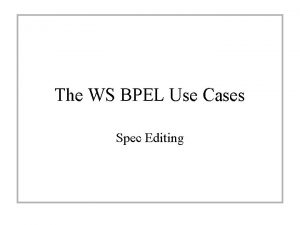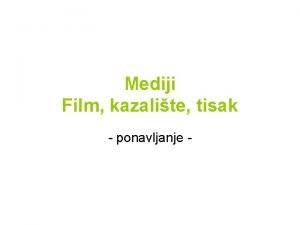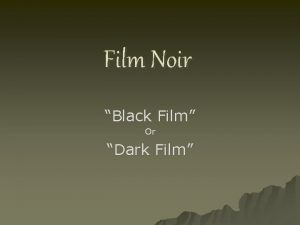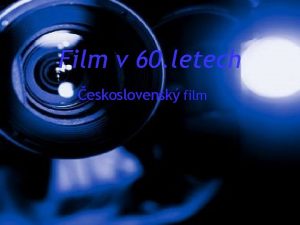EDUQAS A Level Film Studies New Spec 201718
![EDUQAS A Level Film Studies [New Spec 2017/18] Component 1: Varieties of film and EDUQAS A Level Film Studies [New Spec 2017/18] Component 1: Varieties of film and](https://slidetodoc.com/presentation_image_h/27efc5a8a9b4ffe98b90f63b2d27eb51/image-1.jpg)











































![[EXAMPLE – first 2 paragraphs] Compare how gender is represented in one sequence from [EXAMPLE – first 2 paragraphs] Compare how gender is represented in one sequence from](https://slidetodoc.com/presentation_image_h/27efc5a8a9b4ffe98b90f63b2d27eb51/image-45.jpg)
- Slides: 45
![EDUQAS A Level Film Studies New Spec 201718 Component 1 Varieties of film and EDUQAS A Level Film Studies [New Spec 2017/18] Component 1: Varieties of film and](https://slidetodoc.com/presentation_image_h/27efc5a8a9b4ffe98b90f63b2d27eb51/image-1.jpg)
EDUQAS A Level Film Studies [New Spec 2017/18] Component 1: Varieties of film and filmmaking Exam – 2 ½ hours (35%) Section A: Hollywood 1930 -1990 (comparative study) Section B: American film since 2005 (two-film study) Section C: British film since 1995 (two-film study) Component 2: Global filmmaking perspectives Exam – 2 ½ hours (35%) Section A: Global film (two-film study) Section B: Documentary film Section C: Film movements – Silent Cinema Section D: Film movements – Experimental (1960 -2000) Component 3: Production Non-Exam Assessment (30%) 4 -5 minute short film and 1600 word evaluation

Component 1: Varieties of film and filmmaking - Exam – 2 ½ hours – 35% Component 2: Global filmmaking perspectives - Exam – 2 ½ hours – 35% Section A: Hollywood 1930 -1990 (comparative study) Section A: Global film (two-film study) Group 1: Classical Hollywood 1930 -1960) - Casablanca (Curtiz, 1942, U) - The Lady from Shanghai (Welles, 1947, PG) - Johnny Guitar (Ray, 1954, PG) - Vertigo (Hitchcock, 1958, PG) - Some Like It Hot (Wilder, 1959, 12) Group 2: New Hollywood (1961 -1990) - Bonnie and Clyde (Penn, 1967, 15) - OFOTCN (Forman, 1975, 15) - Apocalypse Now (Coppola, 1979, 15) - Blade Runner (Scott, 1982, 15) - Do The Right Thing (Lee, 1989, 15) Section B: American film since 2005 (two-film study) Group 1: Mainstream Film - No Country For Old Men (Coen, 2007, 15) - Inception (Nolan, 2010, 12 A) - Selma (Duvernay, 2014, 12 A) - Carol (Haynes, 2015, 15) - La La Land (Chazelle, 2016) Group 1: European Film - Life is Beautiful (Benigni, Italy, 1997, PG) - Pan’s Labyrinth (Del Toro, Spain, 2006, 15) - Diving Bell (Schnabel, France 2007, 12) - Ida (Pawlikowski, Poland, 2013, 15) - Mustang (Erguven, Turkey, 2015, 15) - Victoria (Schipper, Germany, 2015, 15) Group 2: Outside Europe - Dil Se (Ratnam, India, 1998, 12) - City of God (Meirelles, Brazil, 2002) - House of Flying Daggers (Zhang, China, 2004, 15) - Timbuktu (Sissako, Mauritania, 2014, 12 A) - Wild Tales (Szifron, Argentina, 2014, 15) - Taxi Tehran (Panahi, Iran, 2015, 12) Section B: Documentary film - Sisters in Law (Ayisi, Cameroon, 20015, 12 A) - The Arbor (Barnard, UK, 2010, 15) - Stories We Tell (Polley, Canada, 2012, 12 A) - 20, 000 Days on Earth (Pollard, UK, 2014, 15) - Amy (Kapadia, UK, 2015, 15) Section C: Film movements – Silent Cinema Group 2: Contemporary independent film - Winter’s Bone (Granik, 2010, 15) - Frances Ha! (Baumbach, 2012, 15) - Beasts of the Southern Wild (Zeitlin, 2012, 12 A) - Boyhood (Linklater, 2015, 15) - Captain Fantastic (Ross, 2015, 15) - Keaton compilation (Keaton, 1922, US) - Strike (Eisenstein, USSR, 1924, 15) - Sunrise (Murnau, US, 1927, U) - Spies (Lang, Germany, 1928, PG) - Man With a Movie Camera (Vertov, 1928) - A Propos de Nice (Vigo, France, 1930, U) Section C: British film since 1995 (two-film study) Section D: Film movements – Experimental Film (1960 -2000) - Secrets and Lies (Leigh, 1996, 15) - Trainspotting (Boyle, 1996, 18) - Sweet Sixteen (Loach, 2002, 18) - Shaun of the Dead (Wright, 2004, 15) - This is England (Meadows, 2006, 18) - Moon (Jones, 2009, 15) - Fish Tank (Arnold, 2009, 15) - We Need To Talk About Kevin (Ramsay, 2011, 15) - Sightseers (Wheatley, 2012, 15) - Under the Skin (Glazer, 2013, 15) - Vivre sa vie (Godard, France, 1962, 15) - Daisies (Chytilova, Czech, 1965) - Saute ma ville (Akerman, Belgium, 1968) - Pulp Fiction (Tarantino, US, 1994, 18) - Fallen Angels (Wong, Hong Kong, 1995, 15) - Timecode (Figgis, US, 2000, 15)

Component 1: Varieties of film and filmmaking (AL) Section A: Hollywood 1930 -1990 (comparative study) Group 1: Classical Hollywood (1930 -1960) • • • Core Study Areas: Key Elements of Film Form, Meaning & Response, The Contexts of Film Specialist Study Area: Auteur (AL) Rationale for study: - Some Like It Hot is one of the great American comedies, with witty dialogue, memorable images ad one of the most famous endings in film history. - The film’s cross-dressing and entangled identities challenge traditional sex-roles and enable complex readings. Starting Points: - “Jello on springs” – 23 minutes - “I’m through with love” and “Nobody’s Perfect” – 1 hr 50 mins Core Study Areas 1 – Starting Points – Key Elements of Film Form (micro features) - Cinematography – The film is shot in black and white to connote the historical period (1920 s) and to make the costume and make-up seem less garish and outlandish. - Sugar Kane is often in the centre of the frame with a full light to display her features. The lighting often highlights Marilyn Monroe’s blonde hair, wide eyes and cheekbones. - Spotlighting is used when Sugar Kane (Marilyn Monroe) sings “I Wanna Be Loved By You”, emphasising her beauty and hiding in shadow her transparent dress. - Mise-en-scene - “Objects and costume connote characters’ social status; Spat wears expensive shiny shoes, indicating his superior gangster status, while Charlie’s toothpick suggests his low status. ot H t I e k i L e Som - Forms of transport, such as the train, bicycle, yacht and motorboat, are key motifs emphasising theme of journeys and transformation. - The characters are doubles – Sugar and Daphne are both blondes and act like sisters, while Osgood and Jo dress alike, give the same gifts, and use the same boat. - Editing - The film adheres to the Classical Hollywood mode of continuity editing throughout. - Rapid whip-pans are used in the cuts between Sugar and Jo on the yacht and Daphne and Osgood on the dance-floor to connote the two sites of action happening simultaneously. - The famous “nobody’s perfect” ending is held as a two-shot at eye-level to heighten the comedy – we see the reactions of Osgood and Daphne simultaneously. - Sound - Sugar’s musical performances momentarily halt the narrative and function as both spectacle and an insight into Sugar’s inner feelings e. g. “Runnin’ Wild” and “I Wanna Be Loved by You”. - “I’m through with Love” is used as a dramatic device to reunite Jo and Sugar. - Core Study Areas 2 – Starting Points – Meaning & Response - Representations - Sugar Kane is first represented from a male perspective. The camera fetishizes the bottom half of her body from Jo and Jerry’s point-of-view. On the train, Sugar’s body is further displayed as she removes the brandy flask from her garter. - However, the film then goes beyond presenting women simply as objects of desire, as Jo and Jerry/Daphne gain a greater sensitivity towards women and question their own roles as men. - The film’s playfulness with gender roles can be read in a performative view of gender which defies heteronormativity.

Component 1: Varieties of film and filmmaking (AL) Section A: Hollywood 1930 -1990 (comparative study) Group 1: Classical Hollywood (1930 -1960) - - Aesthetics - Some Like It Hot is cine-literate, evoking the gangster films of the 1930 s with black and white photography and generic iconography. It combines elements of gangster film, the comedy and the musical. - Core Study Areas 3 – Starting Points – Contexts (macro analysis) - Social - Some Like It Hot reflects a changing, more permissive American and the decline in adherence to the Hollywood Production Code. Marilyn Monroe’s overt sexuality represented a new, more open attitude towards sex. - Institutional - The 1948 Paramount Decree marked the end of the dominance of the ‘Big 5’ studios. As a result, smaller studios such as United Artists (UA) took the opportunity to produce major pictures. UA was hugely successful in the 1950 s, with increased profits and A-list stars on non-exclusive contracts, such as Tony Curtis and Rita Hayworth. - Specialist Study Area – Critical Debates - Billy Wilder wrote and directed a diverse range of commercial Hollywood films, including film noirs (Double Indemnity, Sunset Boulevard) and comedies (The Seven Year Itch, The Apartment). What unifies Wilder’s diverse films are themes of deception and disguise, a tight script and witty, memorable dialogue. - Billy Wilder cultivated Marilyn Monroe’s star persona, having previously directed her in The Seven Year Itch (1955). This film, along with Some Like It Hot, contributes to Monroe’s persona as a combination of naivety and alluring sexuality. ot H t I e k i L e Som

Component 1: Varieties of film and filmmaking (AL) Section A: Hollywood 1930 -1990 (comparative study) Group 1: Classical Hollywood (1930 -1960) Some Like It Hot (1959) Plot Summary - When two Chicago musicians, Joe and Jerry, witness the St. Valentine's Day massacre, they want to get out of town and get away from the gangster responsible, Spats Colombo. - They're desperate to get a gig out of town but the only job they know of is in an all-girl band heading to Florida. - They show up at the train station as Josephine and Daphne, the replacement saxophone and bass players. - They certainly enjoy being around the girls, especially Sugar Kane Kowalczyk who sings and plays the ukulele. - Joe in particular sets out to woo her while Jerry/Daphne is wooed by a millionaire, Osgood Fielding III. - Mayhem ensues as the two men try to keep their true identities hidden and Spats Colombo and his crew show up for a meeting with several other crime lords. • • • Writer/Director – Billy Wilder. Screenplay/story – Robert Thoeren and Michael Logan. Original adaptations: - Fanfare of Love (1935, France), Fanfares of Love (1951, Germany) Country – USA Genre – Comedy / Romance. Production company – United Artists (Ashton Productions, Mirisch Corp).

Sugar Kane Kowalcyzk (Marilyn Monroe) Joe/Josephine/Shell Oil Jr. (Tony Curtis) Jerry/Daphne (Jack Lemmon) Little Bonaparte (Nehemiah Persoff) Detective Mulligan (Pat O’Briend) The sexy lead singer and ukulele player of all-girl band that Jerry and Joe join undercover. Sugar is naive, earnest, "not very bright. " She wants to marry a brainy millionaire type with glasses. Joe uses this information as "Josephine" so that the two can fall in love. Joe is Jerry’s best friend, a tenor saxophone player who uses his considerable charm to manipulate. As "Josephine, " Joe becomes one of Sugar's main confidant, a kind of wiser older sister to Sugar's naive romantic. Yet another character that Joe puts on is that of oil tycoon and millionaire "Jr. “ who woos Sugar. Jerry is a worrywart, a practical and put-upon sidekick to the more risk-taking and liberated Joe. He has fun, but he doesn't know how to loosen up. As "Daphne, " Jerry is reactive, romantic, bold, and free. On his romantic date with Osgood, he starts falling for the millionaire, forgetting that he is a man. Little Bonaparte is the mob boss of mob bosses, who has determined that Spats Colombo has got a little too big for his spats. Little Bonaparte is himself the mastermind behind the mobster convention at the Florida hotel, the setting for his murder of Spats. Detective Mulligan is hot on the trail of Spats immediately after the massacre and follows him down to the Florida hotel where Spats, Jerry and Joe are all staying. Mulligan is probing and tough-as-nails, perfectly suited for his tasks of bringing violent, corrupt mobsters to justice. KEY CHARACTERS IN ‘SOME LIKE IT HOT’ Osgood Fielding III (Joe E. Brown) Spats Colombo (George Raft) The all-girl band has been booked to play a hotel in Florida which is mainly populated by wealthy older men who have migrated south for the winter. One of the many older millionaires looking to find younger women is Osgood Fielding III, an eccentric millionaire who says he has been married seven or eight times and who sets his leering eye upon "Daphne. " He is lascivious and will not take "No" for an answer, eventually wooing "Daphne" with a night of dancing at the hotel. Spats is a stone-faced and unflappable mob boss. He runs the speakeasy at which Joe and Jerry work in the beginning, which gets raided by the police early on. To get revenge on another mobster, Toothpick Charlie, for telling the police about the speakeasy, Spats kills Charlie and his friends in the garage where Joe and Jerry just happen to be picking up a car for a gig. After they flee certain death, Joe and Jerry encounter Spats yet again when he comes to a mobster convention at the very same hotel where they are hiding out. Spats is killed by Little Bonaparte. Sweet Sue - The bandleader of the all-girl band that Joe and Jerry join. She is the only one associated with the band who senses that there is something "off" about "Daphne" and "Josephine. " She is very protective of the girls in her band, not wanting them to drink on the job. Beinstock - The traveling manager of Sweet Sue and Her Society Syncopators. Sweet Sue has a domineering habit of yelling “BEINSTOCK” whenever one of the girls in the band causes trouble. Other characters - Sig Poliakoff and Toothpick Charlie

DENOTATIONS AND CONNOTATIONS OF KEY STILLS FROM ‘SOME LIKE IT HOT’ Opening sequence - Tracking long shot - Chase scene – cop cars chase gangsters – gunfire – Prohibition Era (set in Chicago, 1929). The macho alpha male representation of the mob underscores the film. Long shot of Joe and Jerry escaping from a raid at a venue out the back exit. This highlights their role as anti-hero protagonists in this comedy film. Loveable and mischievous rascals. Medium shot of Sugar walking to the train – nondiagetic music changes into a sexy and seductive groove. She represents the conventional siren. Medium two-shot of ‘Daphne’ and Sugar in bed together. Dramatic irony used (audience aware of Daphne’s identity) and Sugar oblivious. Gender identity and social boundaries between genders are explored. Medium two shot of ‘Josephine’ and Sugar sharing and intimate moment. Sugar reveals her desire to marry a spectacled millionaire. Medium shot of Sugar and ‘Junior’ (Jo’s new alter-ego) used to woo Sugar: a shell oil millionaire with spectacles. Medium close-up of Joe and Jerry’s legs as Josephine and Daphne. Non-diagetic upbeat jazz music accompanies. Next shot: reveal of being dressed up in drag (as a disguise from the mob). Enigma code established with shot of legs. The deep focus shot of the pyjama party in ‘Daphne’s’ bed plays with dramatic irony regarding gender. A heteronormative fantasy is subverted as ‘Daphne’ is tickled into a state of agony. Close up of Sugar Kane reinforces Marilyn Monroe’s star persona as a glamorous, desirable woman. She emphasises the role of the heteronormative pin-up.

DENOTATIONS AND CONNOTATIONS OF KEY STILLS FROM ‘SOME LIKE IT HOT’ The medium-close up two shot of Joe as Junior and Sugar Kane has a spotlight on Sugar to enhance her glamorous beauty. Dramatic irony underscores this romantic scene. The long shot of a machine-gun toting gangster in the birthday cake escalates the tension of the crime subplot. The medium shot of Spats Columbo and his mob entourage with machine guns identifies their role as violent criminals in the Prohibition Era underworld of the narrative. The medium two shot of Joe and Sugar where he reveals his true identity and owns up to his lies is met with complete forgiveness. This ‘happily-everafter’ is arguably problematic as Joe faces no consequences for his duplicity. The medium long shot of Joe dressed as Junior and Jerry dressed as Daphne discussing Daphne’s engagement to Osgood is a challenging reference to homosexuality in late 1950 s USA during the final years of the Hays Code. The medium two-shot of Jerry revealing his true identity to Osgood features the film’s classic line “Nobody’s perfect” which could be perceived as a challenge against attitudes towards homosexuality in the 1950 s. Whilst it is by no means a fully affirming representation of LGBTQ rights, it was progressive in its era.

Cinematography in Some Like It Hot – The film is shot in black and white to connote the historical period (1920 s – The Jazz Age) and to make the costume and make -up seem less garish and outlandish. - Sugar Kane is often in the centre of the frame with a full light to display her features. The lighting often highlights Marilyn Monroe’s blonde hair, wide eyes and cheekbones. - Spotlighting is used when Sugar Kane (Marilyn Monroe) sings “I Wanna Be Loved By You”, emphasising her beauty and hiding in shadow her transparent dress.

Mise-en-scene in Some Like It Hot - “Objects and costume connote characters’ social status; Spat wears expensive shiny shoes, indicating his superior gangster status, while Charlie’s toothpick suggests his low status. - Forms of transport, such as the train, bicycle, yacht and motorboat, are key motifs emphasising theme of journeys and transformation. - The characters are doubles – Sugar and Daphne are both blondes and act like sisters, while Osgood and Jo dress alike, give the same gifts, and use the same boat.

Editing in Some Like It Hot - The film adheres to the Classical Hollywood mode of continuity editing throughout to match the linear cause/effect narrative structure. - Rapid whip-pans are used in the cuts between Sugar and Jo on the yacht and Daphne and Osgood on the dance -floor to connote the two sites of action happening simultaneously. - The famous “nobody’s perfect” ending is held as a two-shot at eyelevel to heighten the comedy – we see the reactions of Osgood and Daphne simultaneously.

Sound in Some Like It Hot - Sugar’s musical performances momentarily halt the narrative and function as both spectacle and an insight into Sugar’s inner feelings e. g. “Runnin’ Wild” and “I Wanna Be Loved by You”. - “I’m through with Love” is used as a dramatic device to reunite Jo and Sugar.

Representations in Some Like It Hot - Sugar Kane is first represented from a male perspective. The camera fetishizes the bottom half of her body from Jo and Jerry’s point-of-view. On the train, Sugar’s body is further displayed as she removes the brandy flask from her garter. - However, the film then goes beyond presenting women simply as objects of desire, as Jo and Jerry/Daphne gain a greater sensitivity towards women and question their own roles as men. - The film’s playfulness with gender roles can be read in a performative view of gender which defies heteronormativity.

Dramatic irony as a comedic device • Oscar Wilde and William Shakespeare were masters of comedic dramatic irony in plays such as The Importance of Being Earnest and Much Ado About Nothing – Wilder was clearly influenced by Wilde’s and Shakespeare’s skill of developing narratives around mistaken identities, disguises and a complex web of each character’s goals and obstacles. • In Some Like It Hot, Joe and Jerry are motivated by trying to escape from the mob, but are distracted by their desire to woo Sugar Kane. They both use their costume in order to manipulate the situation to their advantage, but there are complications, particularly as Joe develops three different roles (Joe, Josephine, Shell Oil Junior).

Hays Production Code • The Motion Picture Production Code (Hays Code) was the set of industry moral guidelines that was applied to most US films released by major studios from 1930 to 1968. • Will H. Hays was the president of the Motion Picture Producers and Distributors of America (MPPDA) from 1922 to 1945. Under Hays' leadership, the MPPDA, later known as the Motion Picture Association of America (MPAA), adopted the Production Code in 1930 and began strictly enforcing it in 1934. • The film industry followed the guidelines set by the code well into the late 1950 s, but during this time the code began to weaken due to the combined impact of television, influence from foreign films, and controversial directors pushing boundaries, and intervention from the courts, including the Supreme Court. • In 1968, after several years of minimal enforcement, the Production Code was replaced by the MPAA film rating system.

General Principles 1. No picture shall be produced that will lower the moral standards of those who see it. Hence the sympathy of the audience should never be thrown to the side of crime, wrongdoing, evil or sin. 2. Correct standards of life, subject only to the requirements of drama and entertainment, shall be presented. 3. Law, natural or human, shall not be ridiculed, nor shall sympathy be created for its violation. Particular Applications I. Crimes Against the Law These shall never be presented in such a way as to throw sympathy with the crime as against law and justice or to inspire others with a desire for imitation. 1. Murder a. The technique of murder must be presented in a way that will not inspire imitation. b. Brutal killings are not to be presented in detail. c. Revenge in modern times shall not be justified. 2. Methods of Crime should not be explicitly presented. a. Theft, robbery, safe-cracking, and dynamiting of trains, mines, buildings, etc. , should not be detailed in method. b. Arson must subject to the same safeguards. c. The use of firearms should be restricted to the essentials. d. Methods of smuggling should not be presented. 3. Illegal drug traffic must never be presented. 4. The use of liquor in American life, when not required by the plot or for proper characterization, will not be shown. II. Sex The sanctity of the institution of marriage and the home shall be upheld. Pictures shall not infer that low forms of sex relationship are the accepted or common thing. 1. Adultery, sometimes necessary plot material, must not be explicitly treated, or justified, or presented attractively. 2. Scenes of Passion a. They should not be introduced when not essential to the plot. b. Excessive and lustful kissing, lustful embraces, suggestive postures and gestures, are not to be shown. c. In general passion should so be treated that these scenes do not stimulate the lower and baser element. 3. Seduction or Rape a. They should never be more than suggested, and only when essential for the plot, and even then never shown by explicit method. b. They are never the proper subject for comedy. 4. Sex perversion or any inference to it is forbidden. 5. White slavery shall not be treated. 6. Miscegenation (sex relationships between the white and black races) is forbidden. 7. Sex hygiene and venereal diseases are not subjects for motion pictures. 8. Scenes of actual child birth, in fact or in silhouette, are never to be presented. 9. Children's sex organs are never to be exposed. HAYS PRODUCTION CODE III. Vulgarity The treatment of low, disgusting, unpleasant, though not necessarily evil, subjects should always be subject to the dictates of good taste and a regard for the sensibilities of the audience. IV. Obscenity in word, gesture, reference, song, joke, or by suggestion (even when likely to be understood only by part of the audience) is forbidden. V. Profanity Pointed profanity (this includes the words, God, Lord, Jesus, Christ - unless used reverently - Hell, S. O. B. , damn, Gawd), or every other profane or vulgar expression however used, is forbidden. VI. Costume 1. Complete nudity is never permitted. This includes nudity in fact or in silhouette, or any lecherous or licentious notice thereof by other characters in the picture. 2. Undressing scenes should be avoided, and never used save where essential to the plot. 3. Indecent or undue exposure is forbidden. 4. Dancing or costumes intended to permit undue exposure or indecent movements in the dance are forbidden. VII. Dances 1. Dances suggesting or representing sexual actions or indecent passions are forbidden. 2. Dances which emphasize indecent movements are to be regarded as obscene. VIII. Religion 1. No film or episode may throw ridicule on any religious faith. 2. Ministers of religion in their character as ministers of religion should not be used as comic characters or as villains. 3. Ceremonies of any definite religion should be carefully and respectfully handled. IX. Locations The treatment of bedrooms must be governed by good taste and delicacy. X. National Feelings 1. The use of the Flag shall be consistently respectful. 2. The history, institutions, prominent people and citizenry of other nations shall be represented fairly. XI. Titles Salacious, indecent, or obscene titles shall not be used. XII. Repellent Subjects The following subjects must be treated within the careful limits of good taste: 1. Actual hangings or electrocutions as legal punishments for crime. 2. Third degree methods. 3. Brutality and possible gruesomeness. 4. Branding of people or animals. 5. Apparent cruelty to children or animals. 6. The sale of women, or a woman selling her virtue. 7. Surgical operations.

Aesthetics in Some Like It Hot - Some Like It Hot is cine-literate, evoking the gangster films of the 1930 s with black and white photography and generic iconography. - The film was shot in black and white in order to convey the era in an anachronistic fashion. - Deep focus shots with detailed miseen-scene reveal a Jazz Age context where décor was vibrant, flowery and glamorous.

Context of Some Like It Hot: Representation of The Jazz Age and Prohibition Era • • • 1920 s - sometimes referred to as the Jazz Age, Prohibition Era or the Roaring Twenties. Some Like It Hot may be made in 1959 but it represents the context of the 1920 s. The film was shot in black and white in order to convey the era in an anachronistic fashion. The Prohibition Era – alcohol was banned between 1920 and 1933 by law. As a result, criminal underworlds formed in order to produce alcohol. Some Like It Hot represents gangs that may have existed during this era. The Jazz Age and the Roaring Twenties – the 1920 s was an era of cultural innovation and growth. Modernism was thriving, the economy (before the 1929 Wall Street Crash) was booming and nightlife featured jazz music and the kind of glamour present in novels like The Great Gatsby by F. Scott Fitzgerald. Social - Some Like It Hot reflects a changing, more permissive American and the decline in adherence to the Hollywood Production Code. Marilyn Monroe’s overt sexuality represented a new, more open attitude towards sex. Institutional - The 1948 Paramount Decree marked the end of the dominance of the ‘Big 5’ studios. As a result, smaller studios such as United Artists (UA) took the opportunity to produce major pictures. UA was hugely successful in the 1950 s, with increased profits and A-list stars on nonexclusive contracts, such as Tony Curtis and Rita Hayworth.

Gender representation in Some Like It Hot Historical context on homosexuality and LGBTQ rights - In 1779, Thomas Jefferson wrote a law in Virginia which contained a punishment of castration for men who engage in sodomy. - Prior to 1962, sodomy was a felony in every state, punished by a lengthy term of imprisonment and/or hard labour. - In 1962, the Model Penal Code (MPC) softened their stance against homosexual relations making it only a crime to solicit for sodomy. - By 2002, 36 states had repealed their sodomy laws or their courts had overturned them. • Gender roles - Billy Wilder’s gender representation is remarkably progressive in 1959 – cross-dressing, homosexual undertones between Jerry and Osgood Fielding III, homoerotic undertones between female band players and a challenge against heteronormativity and traditional sex roles. • Feminist critique - would point to the objectification of Marilyn Monroe as a sex symbol. Non-diagetic sultry jazz music, costume, lighting and framing all work to sexualise the representation of Sugar Kane as a screen siren. Despite the subversion of gender normative roles through cross-dressing and implied homosexuality, the representation of Sugar is patriarchal and arguably misogynistic.

Billy Wilder as auteur • • • Skilled at conveying cynicism and irony in popular culture – sharp and witty dialogue Compromised protagonists (anti-heroes with redeeming features) – dramatic irony employed Linear narratives with continuity editing Progressive exploration of gender roles and sexuality Representation of modernity in post-war social life Imagery of American capitalism – themes of innocence and experience (femme fatales) Critical Debates - Billy Wilder wrote and directed a diverse range of commercial Hollywood films, including film noirs (Double Indemnity, Sunset Boulevard) and comedies (The Seven Year Itch, The Apartment). - What unifies Wilder’s diverse films are themes of deception and disguise, a tight script and witty, memorable dialogue. - Billy Wilder cultivated Marilyn Monroe’s star persona, having previously directed her in The Seven Year Itch (1955). This film, along with Some Like It Hot, contributes to Monroe’s persona as a combination of naivety and alluring sexuality.

Component 1: Varieties of film and filmmaking (AL) Section A: Hollywood 1930 -1990 (comparative study) Group 2: New Hollywood (1961 -1990) • • Core Study Areas: Key Elements of Film Form, Meaning & Response, The Contexts of Film Specialist Study Area: Auteur (AL) Rationale for study: - Francis Ford Coppola is renowned as a leading figure in New Hollywood an auteur; along with the Godfather trilogy (1972, 1974, 1990), Apocalypse Now represents his greatest work. It is also significant as one of the greatest anti-war movies and one of the first films to critique the Vietnam War. A film renowned for its production excesses, it remains evidence of a cult film phenomenon which nearly destroyed its producers and some of its principal cast and crew. - The mainly linear narrative takes place at the peak of the Vietnam War (1969) and concerns a battle hardened USA special forces soldier, Captain Willard (Martin Sheen), who is secretly sent upriver, into the depths of the jungles bordering Vietnam, to assassinate a charismatic, rogue American Colonel, Kurtz (Marlon Brando) who is waging his own private war and embarrassing the USA government. Starting Points: - 02. 18 – A composite image of the film’s anti-hero protagonist, Captain Willard. He is significantly shot in an intense BCU and upside down – his world is literally and metaphorically inverted. The central image of a hellish fire consuming beautiful nature reflects how his mind is trapped in the horrific jungle war taking place across Vietnam and the neighbouring countries of Laos and Cambodia. To the left the impassive all-seeing eyes of a Buddhist statue, contrasts his personal chaos with the inner peace of Eastern philosophy. The music accompanying this hypnotic dream-like sequence is the epic song by The Doors (The End). The lyric accompanying this particular set of image is ‘in our desperate land’: referring perhaps to both America and Vietnam. w o N e s p y l a c Apo - 03. 01. 16 – Kurtz’s dying words: ‘The horror…the horror…’ A quote from Marlow, the character whom Kurtz is based on, from Joseph Conrad’s novella, Heart of Darkness. The words refer to the dark centre of human nature that is unleashed in barbarous conditions like those found in an isolated jungle or a chaotic war zone. Core Study Areas 1 – Starting Points – Key Elements of Film Form (micro features) - Cinematography – 02: 35: 25 – Willard finally meets Kurtz in his jungle hideout. This is the first close-up of Kurtz other than archive photographs seen earlier in the film. Whilst talking to Willard, Kurtz emerges out of the darkness like a monster or a dead person – lit with ghoulish yellow (lowkey lighting) – the effect is disturbing. Centrally framed Kurtz seems imposing and dismissive of Willard; a powerful man but one who is both spiritually and physically diseased. - Mise-en-scene - 00. 35 -01. 13 – The first line of The Doors song The End has the mournfully sung lyric ‘This is the End’. The lyric echoes the onscreen destruction of a beautiful and untouched Eden by the devilish nightmare of Napalm (an explosive petroleum jelly). - 47. 19 – Robert Duval as Lieutenant Colonel Kilgore, a tough, brutal and charismatic officer in charge of an Air Cavalry regiment consisting largely of Helicopter gunships. The regiment is summoned to attack a Vietnamese village by bugle call and Kilgore sports a Union officers stetson – the connection to the genocidal destruction of the indigenous Native Americans is made.

Component 1: Varieties of film and filmmaking (AL) Section A: Hollywood 1930 -1990 (comparative study) Group 2: New Hollywood (1961 -1990) Kilgore is a surf loving maverick, so convinced of his indestructibility that he strips to the waist as the counter-attack rages around him. After calling in a napalm attack on the jungle treeline, he utters those eerie, iconic lines: ‘I love the smell of napalm in the morning… It smells like victory. Some day this war is going to end. ’ It’s interesting to think who Kilgore would have blamed for the eventual fall of Saigon in 1975 and the ignominious retreat in defeat by the USA on Helicopters. In Vietnam, the cavalry did not turn up at the last moment to save the day. - Editing - 37: 13 -37: 14 – The dramatic cut from a noisy and bombastic air cavalry attack, accompanied by diegetic Wagnerian music is contrasted in a shocking manner with the peaceful scenes of village life (consisting largely of women and singing schoolchildren). - 00. 10 – 07: 16 – See the opening sequence with its brilliant use of composite cross-dissolves to communicate Willard’s broken state of mind. The sequence is also very useful to explore in terms of all micro features. - Sound - The helicopter attack to Wagner’s stirring The Ride of the Valkyries: the music starts as diagetic but becomes non-diagetic – Wagner was also an anti-Semite – playing on the idea of a racist agenda at work as well as adding to the realism of the scene. - Only seconds after listening to a tape recorded letter from his Mum, Mr Clean, a young boy of 17 (19 was the average of Vietnam conscript) lies dead. The terrible diegetic, contrapuntal sound design as the crew cradle Clean’s corpse and the tape keeps playing is heartbreaking. - 04: 10 -05: 47 - Willard provides voice-over narration throughout the film. His first words (stream of consciousness) occur as he wakes from nightmares that introduce the film and peers through his room’s blinds (a trope of entrapment): w o N e s p y l a c Apo Saigon. Shit! I’m still only in Saigon. Every time I think I am going to wake up back in the jungle…when I was home after my first tour it was worst…I’d wake up and there’d be nothing…I hardly said a word to my wife until I said ‘yes’ to a divorce. When I was here I wanted to be there. When I was there all I could think of was getting back into the jungle. I’m here a week now. Waiting for a mission… Each time I looked around, the walls moved in a little tighter. ” His delivery is deadpan, resigned and depressed. He is a man who has fought so much he has forgotten why he is fighting; all he knows is that he fights. As a representation of a dehumanised soldier, the performance is electrifying. His last voice-over monologue (02: 57: 48) suggests that despite having killed Kurtz, Willard will remain as conflicted and alienated as ever: “They were going to make me a Major for this and I wasn’t even in their fucking army anymore. ” - Core Study Areas 2 – Starting Points – Meaning & Response - Representations - Gender is clearly treated in the film through a lack of female representations. The war is presented to us as a Western man’s war. However, there are many unnamed Vietnamese women portrayed – some playing brave guntoting fighters as well as the more conventional victims of war. Their purposeful and serious identities contrast with the idealised and sexually objectified Western Play Girl centrefolds. - Representations – Age - Age is treated largely through the naivety of Mr Clean and Lance (two teenagers who dance, love rock music, drugs and surfing).

Component 1: Varieties of film and filmmaking (AL) Section A: Hollywood 1930 -1990 (comparative study) Group 2: New Hollywood (1961 -1990) The tragedy of the junk boat massacre, where the Americans slaughter a Vietnamese family, is intensified by the fact that they’re scared trigger-happy kids spooked by a young girl’s attempt to rescue her puppy – the young slaughtering the young. Otherwise, the young Vietnamese we see are conventionally presented as helpless victims. - Representations – Ethnicity - The film set ups from the very beginning the binary opposites of East v West. The film however is presented to us from only the West’s perspective. Even when Willard finally makes it to Kurtz’s jungle hideout, we learn about the man from Dennis Hopper’s drug-addled American photojournalist and not from the mouth of one of his indigenous soldiers. The Vietnamese are largely silent throughout the film. - Representations – Women 3 Real 1973/4 Playboy Playmates entertain the troops deep in the jungle on a surreal set overseen by phallic replicas of missiles. The girls are dressed as a cowgirl, a native American squaw and a Union cavalry officer and dance sexually with guns. These representations are referencing a mythic and violent part of American history where and indigenous race was effectively exterminated by a technically superior white force – an obvious parallel with the fighting in Vietnam. Equally, the sexualisation of the women is a critique of the obscene values imported from the West into the East – one where the phallic power of the gun is fetishized. Local Vietnamese villagers look on bemused through the fencing around the site. The show descends into farce and riot as the soldiers try to mob the girls who fly off in a helicopter. A war zone is no place for fantasy and idealisation. w o N e s p y l a c Apo - These representations of women are the only ones given lengthy screen time in the film’s first release. Coppola addressed this with the Redux release with the inclusion of the two further scenes. The first is with an embittered and embattled enclave of French colonials and an opium smoking Colonist who Willard joins in a pipe and then sleeps with. The second is of two of the Playmates. Their helicopter has been grounded due to lack of fuel. Their tour manager barters time spent with them for fuel. The attempted sex with Lance and Chef is clumsy and awkward and the girls talk in a distracted way with the men as if they are not quite present. The effect of the scene, particularly when one couple accidentally upends an occupied coffin and displays the corpse inside, is very unnerving and distressing. There is no love in their lovemaking: even Willard’s sexual encounter takes place through a gauze of opium and netting. War, it seems, distorts all beauty and feeling – even that feminine feeling offered a conventional counterpoint to male brutality. - Willard arrives in the battle zone, only to discover a camera crew is there before him – Coppola is playing the director of course. The director is yelling at Willard not to stop and not to look at the camera – just like a movie director! This is a selfreflexive critique of the media’s parasitic approach to war – seeing it as a slick spectacle to entertain the masses rather than a grim and confused reality. Aesthetics - War is beautiful – cinematographer Vittorio Storaro shot the principal photography of the film for which he won an Oscar in 1980. Many critics and fans have remarked on the beautiful cinematography – yes, it maybe glorifies something that is hideous but equally it transforms the real into the surreal which was clearly something Coppola wanted to believe.

Component 1: Varieties of film and filmmaking (AL) Section A: Hollywood 1930 -1990 (comparative study) Group 2: New Hollywood (1961 -1990) - War is surreal – see the scenes involving the Playboy girls and then the Media. The scene involving the fighting at the Do Lung Bridge; the ‘Charlie don’t surf’ scene and the helicopter attack and its use of Wagner’s music are equally strange. Throughout the film, river mists and smoke from flares and fires seem to be permanently presenting disorientating barriers in time and place, creating a dream-like atmosphere. Coppola commented on the madness of the film and its theme: ‘ My film is not about Vietnam. It is Vietnam. The way we made it is the way Americans were in Vietnam. We had too much money, too much equipment and little by little we went insane. ’ - War is pointless – The Do Lung Bridge Scene (01: 44: 33) – the arsehole of the world. Chief (the boat’s captain) comments on the futility of war as Willard decides to move on, up river, away from the carnage, derangement and chaos at the Do Lung Bridge: ‘Like this bridge, we build it every night, Charlie blows it right back up again. Just so the generals can say the roads open. ’ - Core Study Areas 3 – Starting Points – Contexts (macro analysis) - Social - A counter-culture classic – anti-war, anti-government, humanist and bleak. As a document of the Vietnam War (1955 -1975) it is peerless. - Historical - One of the first films about a war still fresh in people’s minds. Vietnam was an unpopular war in the USA and around the World; it was also the first TV war, so negative coverage pre-dominated in what became a war of attrition involving huge civilian casualties as well as just over 360, 000 USA dead or wounded. At least 2, 000 Vietnamese civilians died. w o N e s p y l a c Apo - See the boat search scene which ends in tragedy when Willard’s trigger-happy crew get spooked and kill everyone on board only to find that one of the little children was trying to protect a puppy. - Political - Anti-war and clearly offering a counter-cultural view of American interventionist foreign policy and a hypocritical and ineffective military. - Technological - The Oscar-winning sound design and editing by Walter Murch was ground-breaking – for example: using synthesisers to mimic helicopters – all helping to create a hallucinogenic aural atmosphere that perfectly compliments the film’s visuals. The film was the first to be mixed using a computer and is the first to credit anyone as a Sound Designer. The film is also notable for being one of the first released with surround sound or ‘Dolby 5. 1’: a stereo format that is now standard. - Technological - The film was re-released in 2001 with an extra 49 minutes worth of footage – hardly a Director’s Cut but rather a film with missing sequences added by the director from many hours of footage originally shot. - The film won numerous awards – 1979 Cannes Palme D’Or for Best Film and with 8 nominations at the 1980 Academy Awards (won Best Cinematography and Sound). It also did well at the box office on its initial release and Redux release. - The film has two generations of ‘method actor’ (Brando and Sheen) playing opposite each other – however, Brando turned up on set overweight and without having read Conrad’s novel, and Sheen had a nervous breakdown and near-fatal heart attack. - Specialist Study Area – Auteur - Counter-culture – alternative take on Vietname War, America’s interventionist policy, drug taking (hash, LSD, Opium) and liberal music (The Doors, Rolling Stones). - Loose adaptation of Joseph Conrad’s anti-colonial and pessimistic novella, Heart of Darkness (1899).

Component 1: Varieties of film and filmmaking (AL) Section A: Hollywood 1930 -1990 (comparative study) Group 2: New Hollywood (1961 -1990) - Coppola’s wife released a ‘making of’ documentary called ‘Hearts of Darkness: A Filmmaker’s Apocalypse’ in 1991 for the notoriously plagued set - storm destroyed sets, Philippine army requisitioned helicopters loaned to Coppola in order to fight insurgents and culminated with Sheen’s near fatal heart attack. - Francis has also adapted existing literature for screen – Bram Stoker’s Dracula in 1992, Mario Puzo’s The Godfather in 1972. - Films with Catholic vision of human nature corrupted (the fall of man), good and evil in battle, and an epic scale. - Brando can be seen as an auteur – literal and metaphorical weight of whole project – first wave method actor – reputation as difficult performer to work with – intense performances and intense working relationship – magnetic despite weight issues – body double used in some long shots – Brando became obsessed with the character of Kurtz (contributing to film’s budgetary problems) bloated, under-prepared and ultimately obsessed, caused problems. w o N e s p y l a c Apo

Component 1: Varieties of film and filmmaking (AL) Section A: Hollywood 1930 -1990 (comparative study) Group 2: New Hollywood (1961 -1990) Apocalypse Now (1979) • • Plot Summary - It is the height of the war in Vietnam, and U. S. Army Captain Willard is sent by Colonel Lucas and a General to carry out a mission that, officially, 'does not exist - nor will it ever exist'. - The mission: To seek out a mysterious Green Beret Colonel, Walter Kurtz, whose army has crossed the border into Cambodia and is conducting hit-and-run missions against the Viet Cong and NVA. - The army believes Kurtz has gone completely insane and Willard's job is to eliminate him! Willard, sent up the Nung River on a U. S. Navy patrol boat, discovers that his target is one of the most decorated officers in the U. S. Army. - His crew meets up with surfer-type Lt-Colonel Kilgore, head of a U. S Army helicopter cavalry group which eliminates a Viet Cong outpost to provide an entry point into the Nung River. - After some hair-raising encounters, in which some of his crew are killed, Willard, Lance and Chef reach Colonel Kurtz's outpost, beyond the Do Lung Bridge. - Now, after becoming prisoners of Kurtz, will Willard & the others be able to fulfill their mission? Director – Francis Ford Coppola. Writers – Francis Ford Coppola and John Milius (screenplay), Michael Herr (narration), Joseph Conrad (‘Heart of Darkness’ novel). Year – 1979. Country – USA Genre – War / Drama Production company – Zoetrope Studios, United Artists.

Army Captain Benjamin Willard (Martin Sheen) Green Beret Colonel Walter E. Kurtz (Marlon Brando) Lieutenant Colonel Bill Kilgore (Robert Duvall) Chief (Albert Hall) Clean (Laurence Fishburne) A U. S. special forces assassin. He identifies increasingly with his target, Kurtz. Willard perceives the futility and insanity of war. As the protagonist, he is not particularly sympathetic and can even be ruthless and alienating with his troubled mental health. Willard’s target and the destination of film’s journey. Kurtz is a brilliant military man whose wartime experiences have unhinged him. Internalizing the primitivism of the Montagnard army he commands, Kurtz formed a cult around himself. He speaks in grandiose statements about life and death and represents the unconscious, sinister side of humankind. A lunatic, swashbuckling commanding officer of the Ninth Air Cavalry. Kilgore’s methods are senseless and absurd: he plays recordings of Wagner to announce an air strike and orders his men to surf on a Vietcong-controlled beach. In the face of danger, Kilgore is dominating and unflinching. He is a sort of western cowboy: arrogant, heroic, invulnerable. The commanding officer and navigator of the patrol boat that takes Willard upriver. The sombre and disciplined Chief follows military procedure, acts as a father figure to Clean, and feels personally responsible for the fate of his crew. Chief blames Willard for his crew’s predicament and makes his view on the matter very clear but will always follow orders. A seventeen-year-old mechanic from the streets of the South Bronx. Clean represents the young men who fought in Vietnam—those who were still kids and didn’t know anything about war. He is basically cannon fodder, like many of the troops drafted into the war. Clean dances to music and annoys Willard. He becomes momentarily unhinged during the sampan scene. KEY CHARACTERS IN ‘APOCALYPSE NOW’ Chef (Frederic Forrest) Lance (Sam Bottoms) The Photojournalist (Dennis Hopper) General Corman (G. D. Spradin) A saucier from New Orleans who just wants to go home. Chef seems doomed from the start and escapes mentally by smoking dope. He is prone to emotional breakdowns and has a hot temper, fueled by resentment for the war. A cocky young GI and surfer from California. Lance’s descends into the primitive nature of jungle. He transforms from an alert young soldier to a spaced-out druggie who masks his face in camouflage and assimilates to the primitive Montagnard lifestyle at Kurtz’s compound. A hyperactive American freelance photographer and Kurtz worshiper. In the photojournalist’s eyes, Kurtz can do no wrong. The photojournalist has been indoctrinated into Kurtz’s philosophy and acts as a connecting character to bring Willard and Kurtz together. He is the fool to Kurtz’s king. The military superior who outlines Willard’s mission. The grim, no-nonsense Corman is convinced of Kurtz’s insanity and unpredictable violence and is determined to have him killed. The Playboy Playmates (Cynthia Wood, Colleen Camp, and Linda Carpenter) The Sirens of the film. Costumed as a cavalry officer, a cowgirl, and a Native American, the three Playmates play out a farcical history of America in their performance for the troops. They taunt the sex-starved soldiers by being exactly what they can’t have. The Playmates also represent empty American values and the absurdity of war. Captain Richard Colby (Scott Glenn) Willard’s predecessor. The U. S. military sent Colby to assassinate Kurtz before Willard was given the assignment, but Colby ended up getting indoctrinated into Kurtz’s lifestyle and stayed at the compound. Colonel Lucas (Harrison Ford) - Corman’s junior officer. Lucas acts as Corman’s sidekick and briefs Willard with gravity. Jerry (Jerry Ziesner) - A mysterious civilian, possibly an undercover CIA agent.

Historical context of Vietnam War • • The US entered the Vietnam War in an attempt to prevent the spread of Communism – it could be considered a proxy war with the Soviet Union during the Cold War era. Conflict that occurred in Vietnam, Laos and Cambodia from 1955 to the fall of Saigon in 1975. In 1954, then US President Dwight D. Eisenhower, discussed the danger of Communist dictatorships forming across Indochina. The US saw capitalism (free-market ideology) as the ideological hope for a stable world culture and intervened when left-wing governments formed into dictatorships. The Kennedy administration (1961 -63) came closest to escalating the Cold War (with the proxy war in Vietnam) with the possibility of nuclear war by pledging to "pay any price, bear any burden, meet any hardship, support any friend, oppose any foe, in order to assure the survival and success of liberty. “ The anti-war movement was gaining strength in the United States. Nixon appealed to the “silent majority” of Americans who he said supported the war. Opposition to U. S. involvement in the war grew dramatically between 1964 – 73. Revelations of the “My Lai Massacre”, in which a U. S. Army platoon raped and killed civilians outrage. In 1969, “Green Beret Affair” where eight Special Forces soldiers, including the 5 th Special Forces Group Commander Colonel Rheault (whom Kurtz from Apocalypse Now is based on), were arrested for the murder of a suspected double agent (Thai Khac Chuyen in Nha Trang) provoked national and international outrage. The classic phrase “terminate with extreme prejudice” was used in the film and taken from this scandal. In 1971, the Pentagon Papers were leaked to The New York Times. The topsecret history of U. S. involvement in Vietnam detailed a long series of public deceptions on the part of the U. S. government. The Supreme Court ruled that its publication was legal.

Cinematography in Apocalypse Now – 02: 35: 25 – Willard finally meets Kurtz in his jungle hideout. This is the first close-up of Kurtz other than archive photographs seen earlier in the film. Whilst talking to Willard, Kurtz emerges out of the darkness like a monster or a dead person – lit with ghoulish yellow (lowkey lighting) – the effect is disturbing. Centrally framed Kurtz seems imposing and dismissive of Willard; a powerful man but one who is both spiritually and physically diseased.

Mise-en-scene in Apocalypse Now - 00. 35 -01. 13 – The first line of The Doors song The End has the mournfully sung lyric ‘This is the End’. The lyric echoes the onscreen destruction of a beautiful and untouched Eden by the devilish nightmare of Napalm (an explosive petroleum jelly). - 47. 19 – Robert Duval as Lieutenant Colonel Kilgore, a tough, brutal and charismatic officer in charge of an Air Cavalry regiment consisting largely of Helicopter gunships. The regiment is summoned to attack a Vietnamese village by bugle call and Kilgore sports a Union officers stetson – the connection to the genocidal destruction of the indigenous Native Americans is made. Kilgore is a surf loving maverick, so convinced of his indestructibility that he strips to the waist as the counter-attack rages around him. After calling in a napalm attack on the jungle treeline, he utters those eerie, iconic lines: ‘I love the smell of napalm in the morning… It smells like victory. Some day this war is going to end. ’ It’s interesting to think who Kilgore would have blamed for the eventual fall of Saigon in 1975 and the ignominious retreat in defeat by the USA on Helicopters. In Vietnam, the cavalry did not turn up at the last moment to save the day.

Editing in Apocalypse Now - 37: 13 -37: 14 – The dramatic cut from a noisy and bombastic air cavalry attack, accompanied by diegetic Wagnerian music is contrasted in a shocking manner with the peaceful scenes of village life (consisting largely of women and singing schoolchildren). - 00. 10 – 07: 16 – See the opening sequence with its brilliant use of composite cross-dissolves to communicate Willard’s broken state of mind. The sequence is also very useful to explore in terms of all micro features.

Sound in Apocalypse Now - The helicopter attack to Wagner’s stirring The Ride of the Valkyries: the music starts as diagetic but becomes non-diagetic – Wagner was also an anti-Semite – playing on the idea of a racist agenda at work as well as adding to the realism of the scene. (https: //www. youtube. com/watch? v=Tqteht. SB 0 LI) - Only seconds after listening to a tape recorded letter from his Mum, Mr Clean, a young boy of 17 (19 was the average of Vietnam conscript) lies dead. The terrible diegetic, contrapuntal sound design as the crew cradle Clean’s corpse and the tape keeps playing is heart-breaking. - 04: 10 -05: 47 - Willard provides voice-over narration throughout the film. His first words (stream of consciousness) occur as he wakes from nightmares that introduce the film and peers through his room’s blinds (a trope of entrapment): (https: //www. youtube. com/watch? v=nt. PHFVWDIq. M) Saigon. Shit! I’m still only in Saigon. Every time I think I am going to wake up back in the jungle…when I was home after my first tour it was worst…I’d wake up and there’d be nothing…I hardly said a word to my wife until I said ‘yes’ to a divorce. When I was here I wanted to be there. When I was there all I could think of was getting back into the jungle. I’m here a week now. Waiting for a mission… Each time I looked around, the walls moved in a little tighter. ” His delivery is deadpan, resigned and depressed. He is a man who has fought so much he has forgotten why he is fighting; all he knows is that he fights. As a representation of a dehumanised soldier, the performance is electrifying. His last voice-over monologue - (02: 57: 48) suggests that despite having killed Kurtz, Willard will remain as conflicted and alienated as ever: (https: //www. youtube. com/watch? v=Gv 2 s. SLU 8 PJk) “They were going to make me a Major for this and I wasn’t even in their fucking army anymore. ”

Gender representation in Apocalypse Now - Man’s world of war - Gender is clearly treated in the film through a lack of female representations. The war is presented to us as a Western man’s war. However, there are many unnamed Vietnamese women portrayed – some playing brave gun-toting fighters as well as the more conventional victims of war. Their purposeful and serious identities contrast with the idealised and sexually objectified Western Play Girl centrefolds. - Objectification and misogyny - 3 Real 1973/4 Playboy Playmates entertain the troops deep in the jungle on a surreal set overseen by phallic replicas of missiles. The girls are dressed as a cowgirl, a native American squaw and a Union cavalry officer and dance sexually with guns. These representations are referencing a mythic and violent part of American history where and indigenous race was effectively exterminated by a technically superior white force – an obvious parallel with the fighting in Vietnam. Equally, the sexualisation of the women is a critique of the obscene values imported from the West into the East – one where the phallic power of the gun is fetishized. Local Vietnamese villagers look on bemused through the fencing around the site. The show descends into farce and riot as the soldiers try to mob the girls who fly off in a helicopter. A war zone is no place for fantasy and idealisation. - These representations of women are the only ones given lengthy screen time in the film’s first release. Coppola addressed this with the Redux release with the inclusion of the two further scenes. The first is with an embittered and embattled enclave of French colonials and an opium smoking Colonist who Willard joins in a pipe and then sleeps with. The second is of two of the Playmates. Their helicopter has been grounded due to lack of fuel. Their tour manager barters time spent with them for fuel. The attempted sex with Lance and Chef is clumsy and awkward and the girls talk in a distracted way with the men as if they are not quite present. The effect of the scene, particularly when one couple accidentally upends an occupied coffin and displays the corpse inside, is very unnerving and distressing. There is no love in their lovemaking: even Willard’s sexual encounter takes place through a gauze of opium and netting. War, it seems, distorts all beauty and feeling – even that feminine feeling offered a conventional counterpoint to male brutality. - Willard arrives in the battle zone, only to discover a camera crew is there before him – Coppola is playing the director of course. The director is yelling at Willard not to stop and not to look at the camera – just like a movie director! This is a self-reflexive critique of the media’s parasitic approach to war – seeing it as a slick spectacle to entertain the masses rather than a grim and confused reality.

Age representation in Apocalypse Now - Age is treated largely through the naivety of Mr Clean and Lance (two teenagers who dance, love rock music, drugs and surfing). The tragedy of the junk boat massacre, where the Americans slaughter a Vietnamese family, is intensified by the fact that they’re scared trigger - happy kids spooked by a young girl’s attempt to rescue her puppy – the young slaughtering the young. Otherwise, the young Vietnamese we see are conventionally presented as helpless victims.

Ethnic representation in Apocalypse Now - The film set ups from the very beginning the binary opposites of East v West. The film however is presented to us from only the West’s perspective. Even when Willard finally makes it to Kurtz’s jungle hideout, we learn about the man from Dennis Hopper’s drugaddled American photojournalist and not from the mouth of one of his indigenous soldiers. The Vietnamese are largely silent throughout the film.

Aesthetics in Apocalypse Now - War is beautiful – cinematographer Vittorio Storaro shot the principal photography of the film for which he won an Oscar in 1980. Many critics and fans have remarked on the beautiful cinematography – yes, it maybe glorifies something that is hideous but equally it transforms the real into the surreal which was clearly something Coppola wanted to believe. - War is surreal – see the scenes involving the Playboy girls and then the Media. The scene involving the fighting at the Do Lung Bridge; the ‘Charlie don’t surf’ scene and the helicopter attack and its use of Wagner’s music are equally strange. Throughout the film, river mists and smoke from flares and fires seem to be permanently presenting disorientating barriers in time and place, creating a dream-like atmosphere. Coppola commented on the madness of the film and its theme: ‘My film is not about Vietnam. It is Vietnam. The way we made it is the way Americans were in Vietnam. We had too much money, too much equipment and little by little we went insane. ’ - War is pointless – The Do Lung Bridge Scene (01: 44: 33) – the arsehole of the world. Chief (the boat’s captain) comments on the futility of war as Willard decides to move on, up river, away from the carnage, derangement and chaos at the Do Lung Bridge: ‘Like this bridge, we build it every night, Charlie blows it right back up again. Just so the generals can say the roads open. ’

Context of Apocalypse Now - Social - A counter-culture classic – anti-war, antigovernment, humanist and bleak. As a document of the Vietnam War (1955 -1975) it is peerless. Apocalypse Now is a loose adaptation of Joseph Conrad’s 1899 novella - Historical - One of the first films about a war still fresh in people’s minds. Vietnam was an unpopular war in the USA and around the World; it was also the first TV war, so negative coverage pre-dominated in what became a war of attrition involving huge civilian casualties as well as just over 360, 000 USA dead or wounded. At least 2, 000 Vietnamese civilians died. - See the boat search scene which ends in tragedy when Willard’s trigger-happy crew get spooked and kill everyone on board only to find that one of the little children was trying to protect a puppy. - Political - Anti-war and clearly offering a countercultural view of American interventionist foreign policy and a hypocritical and ineffective military.

Context of Apocalypse Now Technological - The Oscar-winning sound design and editing by Walter Murch was ground-breaking – for example: using synthesisers to mimic helicopters – all helping to create a hallucinogenic aural atmosphere that perfectly compliments the film’s visuals. The film was the first to be mixed using a computer and is the first to credit anyone as a Sound Designer. The film is also notable for being one of the first released with surround sound or ‘Dolby 5. 1’: a stereo format that is now standard. - The film was re-released in 2001 with an extra 49 minutes worth of footage – hardly a Director’s Cut but rather a film with missing sequences added by the director from many hours of footage originally shot. - The film won numerous awards – 1979 Cannes Palme D’Or for Best Film and with 8 nominations at the 1980 Academy Awards (won Best Cinematography and Sound). It also did well at the box office on its initial release and Redux release. - The film has two generations of ‘method actor’ (Brando and Sheen) playing opposite each other – however, Brando turned up on set overweight and without having read Conrad’s novel, and Sheen had a nervous breakdown and near-fatal heart attack.

Specialist Study Areas - Counter-culture – alternative take on Vietnam War, America’s interventionist policy, drug taking (hash, LSD, Opium) and liberal music (The Doors, Rolling Stones). - Loose adaptation of Joseph Conrad’s anti-colonial and pessimistic novella, Heart of Darkness (1899). - Documentary - Coppola’s wife released a ‘making of’ documentary called ‘Hearts of Darkness: A Filmmaker’s Apocalypse’ in 1991 for the notoriously plagued set - storm destroyed sets, Philippine army requisitioned helicopters loaned to Coppola in order to fight insurgents and culminated with Sheen’s near fatal heart attack. - Coppola as auteur - Francis has also adapted existing literature for screen – Bram Stoker’s Dracula in 1992, Mario Puzo’s The Godfather in 1972. - Films with Catholic vision of human nature corrupted (the fall of man), good and evil in battle, and an epic scale. - Brando can be seen as an auteur – literal and metaphorical weight of whole project – first wave method actor – reputation as difficult performer to work with – intense performances and intense working relationship – magnetic despite weight issues – body double used in some long shots – Brando became obsessed with the character of Kurtz (contributing to film’s budgetary problems) bloated, under-prepared and ultimately obsessed, caused problems.

60 minutes on one of these questions comparing Some Like It Hot with Apocalypse Now 1 (a) Compare how gender is represented in one sequence from each of your chosen films. Refer to one character from each film. [40] (b) ‘Films reflect aspects of the society in which they were made. ’ Use this quote as a starting point to compare how far your chosen films reflect their social contexts. [40] In your answer, consider: - what you understand by the social context of a film - how your chosen films reflect their different social contexts - to what extent you think your films reflect their social contexts (c) ‘Films always reflect how they were made and who made them. ’ Use this quote as a starting point to compare how far your chosen films reflect their production contexts. [40] In your answer, consider: - what you understand by the production context of a film - how your chosen films reflect their different production contexts - to what extent you think your films reflect their production contexts.

Monday 23 rd April Teacher: Mr Cole-Savidge A LEVEL FILM STUDIES Gender representation in Some Like It Hot and Apocalypse Now Specific Sequences to analyse: Apocalypse Now Sequence: Army gets a visit from Playboy bunnies Consider: - Micro to macro analysis: specific to general - Contexts: Hays Code, Prohibition Era, Jazz Age, Vietnam War, - Characterisation: Compromised protagonists - Ideology: director’s intentions, how social and political values relate to representation - Terms: heteronormativity, homosexuality, transvestites (cross-dressing), role reversal, LGBTQ, gender roles, stereotypes, masculinity, femininity, alpha male, patriarchy, misogyny, objectify, femme fatale, siren, sex symbol, open -minded, censorship, subversion, ideology, stereotype (https: //www. youtube. com/watch? v=k 5 RLLT 5 psmg&safe=active) Some Like It Hot Sequence: Us Girls Should Stick Together (https: //www. youtube. com/watch? v=sp. Akj 5 YYn. Io&safe=active) LO: to analyse the representation of gender within specific contexts of your chosen films. PRACTICE EXAM QUESTION – 50 MINUTES Compare how gender is represented in one sequence from each of your chosen films. Refer to one character from each film. (40)

AO 1 (20 marks) – Demonstrate knowledge and understanding of elements of film. AO 2 (20 marks) – Apply knowledge and understanding of elements of film to compare films. Band 5 - Excellent demonstration of knowledge and understanding of gender representation. - Excellent demonstration of knowledge and understanding of subject specific terminology. Band 5 - Excellent application of knowledge and understanding of gender representation in order to compare films. - Uses excellent points to develop a sophisticated comparison of how far both films reflect gender representations.

CONTROL NATIONALISM FASCISM TOTALITARIANISM NATIONALISTIC SOCIALISM TRADITIONALISM AUTHORITARIANISM STATISM anti-freedom FUNDAMENTALISM Ideology NATIONAL COMMUNISM REPRESENTATION AUTHORITARIAN dictate state focused CONSERVATISM SOCIALISM NEOLIBERALISM Right LEFt SOCIAL DEMOCRACY COMMUNITARIAN LIBERALISM ECONOMY TARIAN PROGRESSIVISM welfare of the people welfare of the economy DEMOCRATIC SOCIALISM LIBERTARIAN freedom of the individual ANARCHOSOCIALISM ACTIVISM LIBERTARIANISM INDIVIDUALISM SYNDICALISM MUTUALISM ANARCHOCOLLECTIVISM ANARCHOCAPITALISM LIBERTARIAN SOCIALISM ANARCHOCOMMUNISM [Source: David Mc. Candless ‘Knowledge is Beautiful’] LIBERTARIAN CAPITALISM ANARCHISM CONNECT relate CHAOISM anti state

HELP SHEET – STRUCTURING EXAM RESPONSES – MICRO to MACRO FOCUS Denotation Connotation Representation The medium two-shot of Jerry revealing his true identity to Osgood at the denouement of the film features the film’s classic line “Nobody’s perfect”. This highlights the homosexual undertones of Wilder’s film where Osgood would consider a relationship with a crossdressing man on the revelation that Daphne is in fact Jerry. This could be perceived as a challenge towards heteronormative representations of masculinity in the 1950 s. Whilst it is by no means a fully affirming representation of LGBTQ rights, it was progressive in its era. Wilder was known for provoking conservative attitudes in Hollywood and promoted a more liberal, sexpositive attitude. Mid-sentence connectives Connectives For example For instance However On the other hand In other words Firstly, secondly, finally In addition Furthermore Consequently Similarly In contrast emphasises highlights shows depicts infers illustrates represents reinforces Likewise underlines identifies implies suggests Although explains symbolises embodies typifies Nevertheless indicates defines portrays clarifies counters dismisses denies accepts Despite this gives the impression conveys creates the impression such as Instead As a result
![EXAMPLE first 2 paragraphs Compare how gender is represented in one sequence from [EXAMPLE – first 2 paragraphs] Compare how gender is represented in one sequence from](https://slidetodoc.com/presentation_image_h/27efc5a8a9b4ffe98b90f63b2d27eb51/image-45.jpg)
[EXAMPLE – first 2 paragraphs] Compare how gender is represented in one sequence from each of your chosen films. Refer to one character from each film. [40] In Some Like It Hot (1959) The medium two-shot of ‘Daphne’ and Sugar in bed together. Dramatic irony is used for comedic effect. The audience aware of Daphne’s identity (Jerry) and Sugar is oblivious. In a crime thriller film, this could have voyeuristic and misogynistic connotations, but Wilder extracts humour from the scene as Daphne and Sugar’s bond seems sisterly whilst Jerry’s desires to woo sugar cannot be fulfilled whilst in this disguise. His own duplicity becomes the main stumbling block despite the intimacy that comes with being perceived as part of the same gender. In addition, the deep focus shot of the pyjama party in ‘Daphne’s’ bed reinforces a heteronormative fantasy but it is subverted as ‘Daphne’ is tickled into a state of agony. It seems his deceit has led to a comeuppance. Wilder plays with the audience’s expectations, subverting gender representation in a whimsical fashion and never fully appealing patriarchal desires. Heteronormative fantasies are also explored in Apocalypse Now (1979). The long shot of a stage reveals an army full of salivating soldiers who objectify a Playboy playmate strutting around for their pleasure in a revealing cowgirl costume. Guns are used as phallic objects as cat-calling and wolf-whistling soldiers encourage the sexual parade with lustful glee. Liberal values are highlighted in this scene, where Western gender representation in the 1970 s promotes promiscuity and sexual freedom (partly as a result of the Beatnik revolution where hippie lifestyles encouraged ‘free love’). As a result of this sexual awakening, it often descended into misogynistic contexts where objectification of women was rampant. The testosterone -filled context of soldiers at war away from girlfriends and wives heightens the intensity, morally objectionable nature and tribal quality of this scene. Coppola villainises the Americans not the Vietnamese.
 Wjec eduqas film studies for a level & as
Wjec eduqas film studies for a level & as Eduqas religious studies a level past papers
Eduqas religious studies a level past papers A level film studies past papers
A level film studies past papers Aqa a level psychology specification
Aqa a level psychology specification Eduqas gcse media
Eduqas gcse media Re past papers eduqas
Re past papers eduqas Wjec past papers law
Wjec past papers law English literature a level wjec
English literature a level wjec Eduqas english literature a level
Eduqas english literature a level Midwinter grahame davies
Midwinter grahame davies Eduqas a level music resources
Eduqas a level music resources Vogue 1965 media studies
Vogue 1965 media studies Eduqas a level english literature
Eduqas a level english literature Eduqas english literature past papers a level
Eduqas english literature past papers a level Eduqas geology a level
Eduqas geology a level Wjec unit 4 criminology
Wjec unit 4 criminology Eduqas english language and literature
Eduqas english language and literature Gcse electronics
Gcse electronics Eduqas a level music revision
Eduqas a level music revision Eduqas a level music resources
Eduqas a level music resources Eduqas design and technology
Eduqas design and technology Wjec a level electronics
Wjec a level electronics Eduqas law a level
Eduqas law a level A level law wjec
A level law wjec Eduqas a level music
Eduqas a level music Eduqas a level english literature
Eduqas a level english literature Slipper or guide bearing
Slipper or guide bearing Montage in film studies
Montage in film studies Film studies ppt
Film studies ppt Film studies terminology
Film studies terminology Cantered angle
Cantered angle Paradigm shift from women studies to gender studies
Paradigm shift from women studies to gender studies Juniper ex2300m
Juniper ex2300m 2-methyl-2-butanol ir
2-methyl-2-butanol ir Människans hörselområde
Människans hörselområde High resolution
High resolution Mass spec fragments
Mass spec fragments Latin roots spec
Latin roots spec Spec sizer
Spec sizer Spec cpu 2000
Spec cpu 2000 Computer organization & architecture: themes and variations
Computer organization & architecture: themes and variations Bluetooth protocol specification
Bluetooth protocol specification Txdot spec book
Txdot spec book Nvme mi
Nvme mi Spec sfs 2020
Spec sfs 2020 Nasa std 6001
Nasa std 6001
